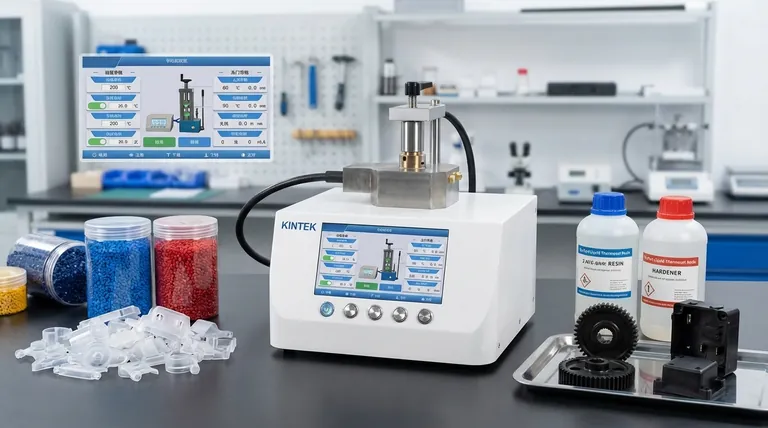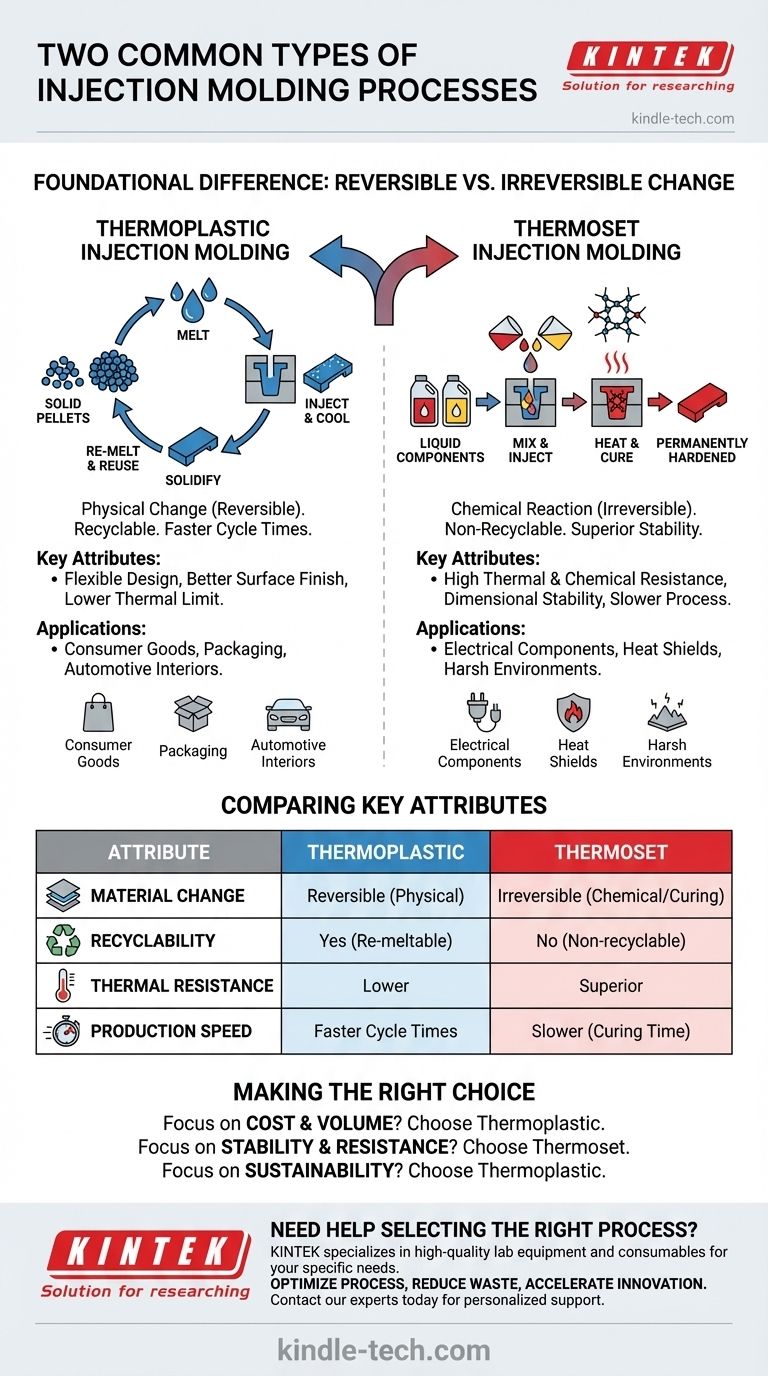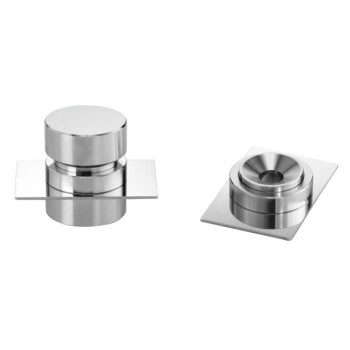In practice, the two most common and fundamental types of injection molding are defined by the class of polymer used: Thermoplastic Injection Molding and Thermoset Injection Molding. While numerous specialized techniques exist, these two processes form the foundation of plastic part manufacturing, differing primarily in how the material behaves when heated and cured.
The core distinction is simple: thermoplastic molding involves a reversible physical change (melting and cooling), making the material recyclable, while thermoset molding involves an irreversible chemical reaction (curing), creating a more stable but non-recyclable part.

The Foundational Difference: Reversible vs. Irreversible Change
The choice between these two processes is one of the first and most critical decisions in product design. It hinges on the material's reaction to heat, which dictates the final part's properties, performance, and lifecycle.
What is Thermoplastic Injection Molding?
Thermoplastic injection molding is the most prevalent form of the technology. It uses plastic polymers that can be repeatedly melted and solidified without significant degradation.
The process is straightforward: solid plastic pellets are melted, injected under high pressure into a cooled mold, and then solidify into the desired shape.
Because this is a physical change, not a chemical one, the process is reversible. Scrap material and end-of-life parts can be ground up and reused, making it a more sustainable option.
What is Thermoset Injection Molding?
Thermoset molding uses polymers that start as liquids and are permanently hardened through a chemical reaction called curing.
In this process, two separate liquid components are often mixed before being injected into a heated mold. The heat initiates an irreversible cross-linking chemical reaction, curing the liquid into a rigid solid.
Once a thermoset part is cured, it cannot be melted again. Attempting to heat it will cause the material to char and degrade, not liquefy.
Comparing Key Attributes and Applications
The profound difference in material behavior leads to distinct advantages and use cases for each process.
Mechanical Strength and Dimensional Stability
Thermosets generally offer superior dimensional stability and structural integrity, especially under load and at high temperatures, due to their rigid, cross-linked molecular structure.
Thermal and Chemical Resistance
This is the primary advantage of thermosets. Their cured structure makes them highly resistant to heat, corrosion, and chemical attack, making them ideal for harsh environments.
Surface Finish and Design Flexibility
Thermoplastics often provide a better surface finish straight from the mold and allow for greater flexibility in design, including features like living hinges. They are available in a vast array of colors and clarities.
Production Speed and Cost
Thermoplastic molding typically has faster cycle times. The process only requires the material to cool and solidify, whereas thermosets must remain in the mold long enough for the chemical reaction to complete.
Understanding the Trade-offs
Neither process is universally superior; the correct choice depends entirely on the application's demands and constraints.
The Irreversibility of Thermosets
The inability to re-melt thermosets is their greatest strength and weakness. It provides incredible stability but means that scrap material from production cannot be reused, and the final parts are not recyclable.
The Temperature Sensitivity of Thermoplastics
The re-meltable nature of thermoplastics makes them versatile and recyclable. However, this also means they have a lower maximum service temperature and can deform if exposed to conditions beyond their thermal limits.
Specialized Process Variations
Beyond these two foundational types, many specialized techniques exist. Processes like Overmolding (molding one plastic over another) or Metal Injection Molding (using metal powders with a binder) are advanced methods used to achieve specific product requirements, but they still operate on similar core principles of injection and solidification.
Making the Right Choice for Your Goal
Selecting the correct process requires aligning your product's primary requirements with the fundamental strengths of the material.
- If your primary focus is cost-effective, high-volume production with design flexibility: Thermoplastic injection molding is the default choice for consumer goods, packaging, and automotive interiors.
- If your primary focus is maximum thermal stability and chemical resistance: Thermoset injection molding is essential for electrical components, heat shields, and parts exposed to harsh industrial environments.
- If your primary focus is sustainability and recyclability: Thermoplastic injection molding is the only viable option between the two.
Understanding the fundamental difference between these processes empowers you to make an informed decision that ensures your part performs as intended.
Summary Table:
| Attribute | Thermoplastic Injection Molding | Thermoset Injection Molding |
|---|---|---|
| Material Change | Reversible (Physical) | Irreversible (Chemical/Curing) |
| Recyclability | Yes (Re-meltable) | No (Non-recyclable) |
| Thermal Resistance | Lower | Superior |
| Primary Applications | Consumer Goods, Automotive Interiors | Electrical Components, Heat Shields |
| Production Speed | Faster Cycle Times | Slower (Due to Curing Time) |
Need Help Selecting the Right Molding Process for Your Lab or Production Needs?
Choosing between thermoplastic and thermoset injection molding is critical for achieving the desired part performance, cost-efficiency, and sustainability. At KINTEK, we specialize in providing high-quality lab equipment and consumables tailored to your specific requirements. Whether you're prototyping, testing materials, or scaling production, our expertise ensures you have the right tools to succeed.
Let us help you:
- Optimize your process with reliable equipment designed for precision and durability.
- Reduce waste and costs by selecting the ideal materials and methods for your application.
- Accelerate innovation with solutions that support both thermoplastic and thermoset workflows.
Ready to enhance your injection molding outcomes? Contact our experts today for personalized support and discover how KINTEK can empower your laboratory's success!
Visual Guide

Related Products
- Double Plate Heating Press Mold for Lab
- Warm Isostatic Press for Solid State Battery Research
- Warm Isostatic Press WIP Workstation 300Mpa for High Pressure Applications
- 24T 30T 60T Heated Hydraulic Press Machine with Heated Plates for Laboratory Hot Press
- Lab Infrared Press Mold
People Also Ask
- Does a hydraulic press have heat? How Heated Platens Unlock Advanced Molding and Curing
- What role does a benchtop hot press play in densifying composite cathodes? Achieve <10% Porosity with Thermo-Mechanical Flow
- What role do molds play in the formation of Ruthenium sheets? Master High-Density Ruthenium Fabrication
- Why is it necessary to use high-precision temperature-controlled heating furnaces? Secure Natural Fiber Integrity.
- What does a hot press machine do? Permanently Bond, Form, or Transfer Materials with Precision



















